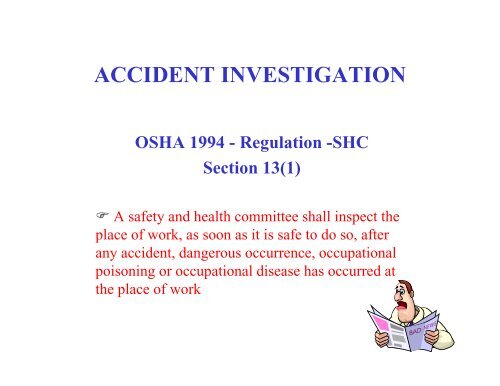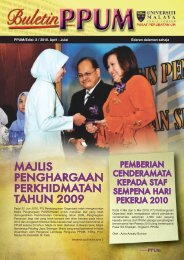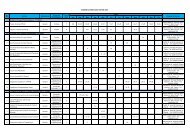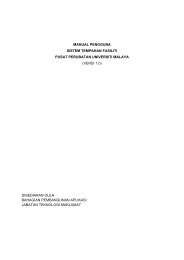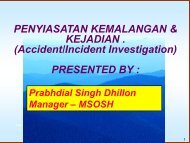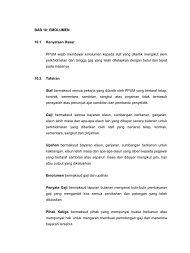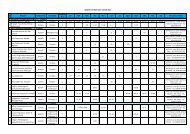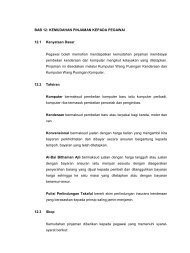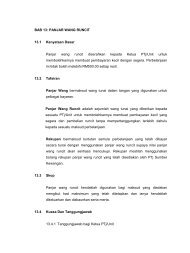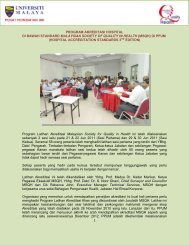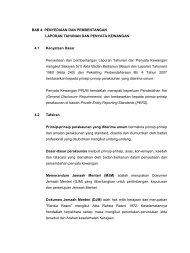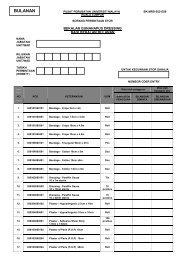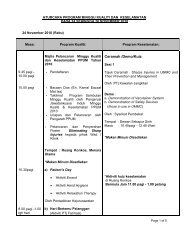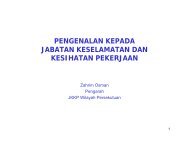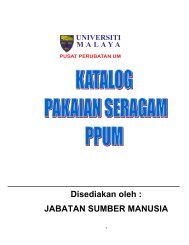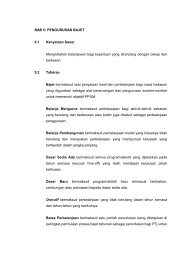ACCIDENT INVESTIGATION
ACCIDENT INVESTIGATION
ACCIDENT INVESTIGATION
Create successful ePaper yourself
Turn your PDF publications into a flip-book with our unique Google optimized e-Paper software.
<strong>ACCIDENT</strong> <strong>INVESTIGATION</strong><br />
OSHA 1994 - Regulation -SHC<br />
Section 13(1)<br />
A safety and health committee shall inspect the<br />
place of work, as soon as it is safe to do so, after<br />
any accident, dangerous occurrence, occupational<br />
poisoning i or occupational ldisease has occurred at<br />
the place of work
<strong>ACCIDENT</strong> <strong>INVESTIGATION</strong><br />
POLICY<br />
Objective of incident investigation should not<br />
be to apportion blame or fault finding but to<br />
determine the cause(s) in order to prevent<br />
recurrence of accident<br />
All i id t t b t d d d<br />
All incidents must be report, recorded and<br />
investigated by competent
<strong>ACCIDENT</strong> <strong>INVESTIGATION</strong><br />
POLICY<br />
All staff must give their full cooperation and<br />
assistance when requested, to the investigation<br />
team<br />
All recommendations arising from incident<br />
investigation must tbe discussed, d agreed and<br />
executed by the relevant action parties
<strong>ACCIDENT</strong> <strong>INVESTIGATION</strong><br />
Definition<br />
Incident<br />
• an unplanned event or chain of event, which has or could<br />
have caused injury or illness to people and/or damage (loss) to<br />
assets, the enviroment e.g near miss, accident, fire<br />
Accident<br />
• an event which resulted injuries or illness to people and/or<br />
damage (loss) to assets and the enviroments<br />
Near miss<br />
• an event which did not result in injuries or illness to people<br />
j p p<br />
and/or damage (loss) to assets and the enviroment
<strong>ACCIDENT</strong> <strong>INVESTIGATION</strong><br />
<strong>ACCIDENT</strong> - THE CONSEQUENCES<br />
Immediate<br />
• Death<br />
• Injury<br />
• Pain<br />
• Disease<br />
• Damage<br />
• Loss<br />
• Fear<br />
Short Term<br />
• Medical<br />
Treatment<br />
• Repairs<br />
• Replacement<br />
• Lost<br />
Production<br />
• Increased<br />
Cost<br />
• Disciplinei • Low Morale<br />
Long Term<br />
•Suffering<br />
•Disability<br />
•Lost Income<br />
•Insurance<br />
•Compensation<br />
•Mistrust<br />
•Profitability
<strong>ACCIDENT</strong> <strong>INVESTIGATION</strong><br />
Safety Iceberg<br />
1 Fatality<br />
100<br />
1,000<br />
10,000000<br />
100,000<br />
Lost Time Injuries<br />
Minor Injuries/Property<br />
damage<br />
Near Misses<br />
Unsafe Acts / Conditions
<strong>ACCIDENT</strong> <strong>INVESTIGATION</strong><br />
Purpose<br />
INCIDENT <strong>INVESTIGATION</strong><br />
• Law (OSHA 1994) and Company requirements<br />
• Prevent recurrence<br />
• Essential element in Safety & Health Management<br />
• Contribute to good morale and overall safety<br />
awareness<br />
• Geared towards continuous OSH improvement thus<br />
increased productivity and improved work enviroment
<strong>ACCIDENT</strong> <strong>INVESTIGATION</strong><br />
AIM<br />
To find the root cause and to prevent recurrence<br />
Not to apportion or assign blame, satisfy<br />
Not to apportion or assign blame, satisfy<br />
insurance claims or defend against liabilities
<strong>ACCIDENT</strong> <strong>INVESTIGATION</strong><br />
TYPES OF INCIDENTS<br />
Injurious accident<br />
Non-injurious incident with asset damage<br />
Occupational illness or disease<br />
Near miss
<strong>ACCIDENT</strong> <strong>INVESTIGATION</strong><br />
Minor accident<br />
<strong>INVESTIGATION</strong> PARTIES<br />
• Relevant individual staff and/or line supervisor<br />
Major accident<br />
• Team comparising mixed discpline and expertise<br />
including safety personel and led by line manager
<strong>ACCIDENT</strong> <strong>INVESTIGATION</strong><br />
<strong>INVESTIGATION</strong> PARTIES<br />
Be objective and be impartial<br />
Gather the facts and information<br />
Isolate the contributor factors<br />
Determine corrective actions and action parties<br />
Implement corrective actions with target dates
<strong>ACCIDENT</strong> <strong>INVESTIGATION</strong><br />
METHODOLOGY<br />
Gather safety rules/procedures of the site and<br />
information on plant, machinery or facilities<br />
Isolate the scene of accident and do not disturb<br />
evidence<br />
Take photos, sketch, diagrams of the accident<br />
site/facilities<br />
Interview witnesses, affected or involed parties and<br />
obtain facts but not opinions or assumptions<br />
Isolate key contributory factors
<strong>ACCIDENT</strong> <strong>INVESTIGATION</strong><br />
OUTCOMES OF THE INCIDENT<br />
Negative results like death, injuries, production<br />
loss, property damage<br />
Positive results like rehabilitation, change in<br />
safety procedures, improvement in processes
<strong>ACCIDENT</strong> <strong>INVESTIGATION</strong><br />
CONTRIBUTORY FACTORS<br />
Environment e.g. noise, heat, light, fumes, bad weather<br />
Design e.g. worksite layout, tools/equipment<br />
Systems and procedures e.g. not present or inapproprite<br />
Human behaviour e.g unsafes acts, purchase wrong type<br />
of equipment
<strong>ACCIDENT</strong> <strong>INVESTIGATION</strong><br />
CAUSES OF INCIDENTS<br />
Immediate e.g. Unsafe act, using unsafe tools/equipment,<br />
incorrect procedures, poor housekeeping, unsafe<br />
condition<br />
Uderlying e.g. Poor training, poor maintenance, low<br />
safety morale, lack of enforcement of safety rules
<strong>ACCIDENT</strong> <strong>INVESTIGATION</strong><br />
<strong>INVESTIGATION</strong> INTERVIEW<br />
TECHNIQUES<br />
Inprivate<br />
Put them at ease<br />
State objective for accident prevention<br />
Blame - free environment<br />
Establish facts only<br />
No leading question<br />
Give appreciation
<strong>ACCIDENT</strong> <strong>INVESTIGATION</strong><br />
1. Event leading to the<br />
accident<br />
• System of work<br />
• Work instruction<br />
• Variations from safe<br />
practice/instruction<br />
• Workplace condition<br />
• Environment condition<br />
• Exact location of incident<br />
• Material/Equipment/Tool<br />
used or handled<br />
2. Facts of the Incident<br />
itself<br />
• State of system<br />
• Parties involed<br />
• Material/Equipment/Tool<br />
/fixtures in direct<br />
involement<br />
3. Relevant facts of what<br />
happened immediately<br />
after the incident<br />
• Direct resultant injuries<br />
to people damage to<br />
assets or environment<br />
• Event leading to<br />
consequential injuries i or<br />
assets/environment<br />
damage<br />
• Parties involed including<br />
emergency respons or<br />
recovery<br />
• Effectiveness of<br />
emergency respons or<br />
recovery
CHECKLIST TO ESTABLISH<br />
FACTS OF INCIDENT<br />
WHO<br />
WHAT<br />
• was injured<br />
• is the injury<br />
• saw incident<br />
• is the damaged or loss<br />
• working with injured<br />
• is the injured doing<br />
• assigned job to injured<br />
• had the injured been instruced to do<br />
• else was involved<br />
• tools were being used<br />
• has information leading to the incident • machine/plant/equipment was in use<br />
• previous similar accident or near misses<br />
and whether action had been taken to<br />
prevent recurrence<br />
• did the injured and witnesses see<br />
• safety rules were violated<br />
• safe system of work, permit/procedures<br />
• were the contributory causes of the<br />
accident<br />
• communication system was in use
CHECKLIST TO ESTABLISH<br />
FACTS OF INCIDENT<br />
WHERE<br />
HOW<br />
• did accident occur<br />
• did the damage occur<br />
• was the supervisor at that time<br />
• were the witnesses at that time<br />
• did the injury occur<br />
• was the medical response<br />
• could the accident been avoided<br />
• could better design help<br />
• could the supervisor have prevented the<br />
accident
CHECKLIST TO ESTABLISH<br />
FACTS OF INCIDENT<br />
WHEN<br />
• did the accident occur<br />
• did the comunication fail<br />
• did the injured start the job<br />
• was hazards explained<br />
• did the supervisor last see the injured<br />
• as something observed to be wrong<br />
WHY<br />
• did the injury occur<br />
• did communication fail<br />
• was training not given<br />
• were the unsafe condition permitted<br />
• were the hazard not evaluated<br />
• was PPE not given or not worn<br />
• was there no safe system of work,<br />
permitted or procedures<br />
• were specific instructions not given<br />
• was there no safety inspection or audit<br />
• was the level of safety awareness and<br />
commitment low<br />
• was there no safety program<br />
• was the injured there<br />
• was supervisor not notified when things<br />
went wrong<br />
• was the supervisor not there at the time
<strong>ACCIDENT</strong> <strong>INVESTIGATION</strong><br />
<strong>ACCIDENT</strong> CAUSATION<br />
Over 90% of all accident are caused by the action or inaction’s of<br />
people which are unsafe acts or unsafe conditions<br />
<br />
Recognise patterns of accident<br />
• people - any particular group or individual<br />
• behaviour - poor safety attitude<br />
• time- particular time, day, start/end week, shift<br />
• place - particular place, type of place, indoor/outdoor<br />
• activity - during a particular task, type of task, boring gj job, high<br />
speed, during difficult or complex task<br />
• system or procedures - any particular operations, system or<br />
procedures<br />
• equipment - specific type, old or new
<strong>ACCIDENT</strong> <strong>INVESTIGATION</strong><br />
1. Unsafe Acts<br />
• failure to wear PPE<br />
• wearing unsafe clothing<br />
• horseplay<br />
• improper use of hands and other parts of the body<br />
• bypassing safety devices<br />
• unsafe position or posture<br />
• driving errors<br />
• unsafe operation acts
<strong>ACCIDENT</strong> <strong>INVESTIGATION</strong><br />
2. Unsafe Conditions<br />
• defective tools and equipment<br />
• df defective design<br />
• unsafe clothing or PPE<br />
• unsafe workplace<br />
• inadequate layout and storage<br />
• unsafe guarding<br />
g<br />
• public hazards
BENEFIT OF <strong>ACCIDENT</strong><br />
<strong>INVESTIGATION</strong><br />
Prevent recurrence<br />
Identify out-moded operartion methods<br />
Improved work environment<br />
Increased productivity due to upgrading of process<br />
system<br />
Raising of safety awareness and morale<br />
Lower medical costs due to fewer accidents<br />
Avoid lawsuits or liabilities due to accidents<br />
Greater efficiency due to no work stoppages
<strong>ACCIDENT</strong> <strong>INVESTIGATION</strong><br />
<strong>ACCIDENT</strong> REPORTING FORM<br />
(refer to handout)<br />
DOSH - Accident Reporting Form<br />
Company - Accident Reporting Form<br />
Witness Interview Form
<strong>ACCIDENT</strong> <strong>INVESTIGATION</strong><br />
PRINCIPLES OF <strong>ACCIDENT</strong><br />
PREVENTION<br />
The identification of hazards, risk assessment and risk<br />
control<br />
OSH promotion and communication to influence<br />
behaviour and encourage safe attitudes


